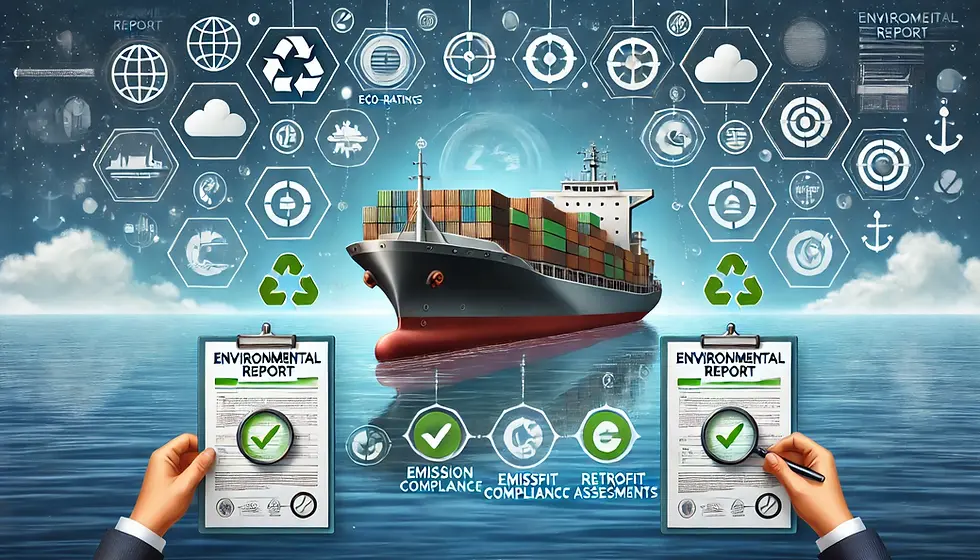Environmental reports for ship purchases: importance, implementation and tips for buyers and sellers
- Davide Ramponi

- 27. Jan.
- 3 Min. Lesezeit
Aktualisiert: 29. Mai
My name is Davide Ramponi, I'm 20 years old and I'm currently training to be a shipping agent in Hamburg. On my blog, I take you with me on my journey into the exciting world of shipping. I share my knowledge, my experiences and my progress on my way to becoming an expert in the field of Sale and Purchase - the trade with ships.

The shipping industry is at a turning point: environmental regulations and sustainability goals are affecting not only the operation of ships, but also their market value. An environmental report is therefore a key part of the purchasing process. But what exactly is an environmental report and why is it so important? In this article, I explain the basics, show how environmental regulations affect the value of a ship and give tips on how buyers and sellers can benefit from an environmental report.
What is an environmental report and why is it important?
An environmental report assesses the ecological condition of a ship and checks whether it complies with the applicable environmental regulations. It is an essential step in the purchasing process as it not only fulfils legal requirements but also minimises financial and operational risks.
Contents of an environmental report:
Evaluation of emission values (CO₂, sulphur, nitrogen oxides).
Review of waste disposal and the ballast water management system.
Analysing the efficiency of machines and drives with regard to environmental standards.
Why is it important?
Legal compliance: An environmental report ensures that the ship complies with international regulations such as IMO 2023 (CII, EEXI).
Financial planning: It helps buyers to plan potential costs for retrofitting or modernisation in advance.
Market attractiveness: Ships with positive environmental ratings are more in demand and command higher prices.
How environmental regulations affect the value of a ship
The introduction of strict environmental regulations has significantly changed the market value of ships. Here are the main effects:
Positive valuation:
Ships equipped with modern technologies such as scrubber systems or LNG propulsion fulfil current environmental regulations and command higher prices.
Negative valuation:
Older ships that do not meet the latest standards lose market value and can often only remain competitive through expensive retrofits.
Long-term perspective:
Buyers prefer ships that are future-proof and can also fulfil upcoming environmental regulations, which increases the demand for modern and energy-efficient ships.
Steps for carrying out a survey
An environmental survey is a structured process that consists of several steps. Here's how it works:
Data analysis:
The surveyor collects technical and operational data of the vessel, including engine logs and classification reports.
Technical inspection:
An on-site inspection checks the physical equipment, including emission systems, ballast water management and exhaust gas cleaning.
Environmental assessment:
The results of the inspection are compared to applicable regulations to determine if the vessel is compliant or if retrofits are required.
Preparation of the report:
The assessor prepares a detailed report summarising the findings and making recommendations for possible retrofits or improvements.
Pitfalls with older ships
Older ships often present particular challenges when it comes to environmental assessments. Here are some typical pitfalls:
Outdated technology:
Older ships often do not have modern exhaust gas cleaning systems or ballast water management systems, requiring expensive retrofits.
Lack of documentation:
Incomplete or outdated maintenance reports can make valuation difficult and lead to uncertainty among buyers.
High operating costs:
Vessels with inefficient machinery incur higher operating costs and are less attractive to potential buyers.
Tips for buyers and sellers
An environmental report can provide valuable insights for both buyers and sellers. Here are some tips to get the most out of the process:
For buyers:
Request an appraisal:
Insist on having an up-to-date environmental report before making a purchase decision.
Consider the costs:
Factor potential retrofit costs into your budget planning to avoid surprises.
For sellers:
Prepare yourselves:
Conduct an environmental assessment before you put the vessel on the market to provide transparency to potential buyers.
Retrofits are worthwhile:
Invest in technologies such as scrubber systems or energy-efficient drives to increase the value of the vessel.
Conclusion
An environmental report is an indispensable part of the modern purchasing process. It not only offers buyers security, but also helps sellers to increase the value of their ship and find buyers more quickly. With the right steps and a clear strategy, both parties can reap the benefits of a survey.
I hope this article has given you an insight into the importance of environmental surveys in the sale and purchase sector. Have you already had experience with this topic? Share your thoughts and questions in the comments - I look forward to hearing from you!

Source:
ChatGPT
Picture:
ChatGPT




Kommentare